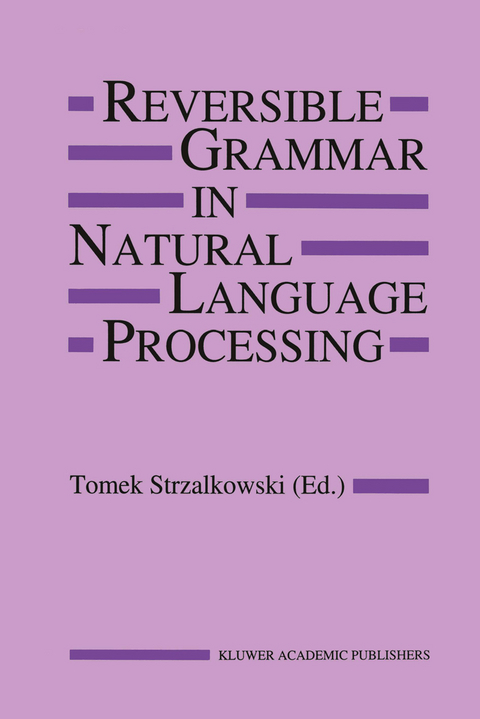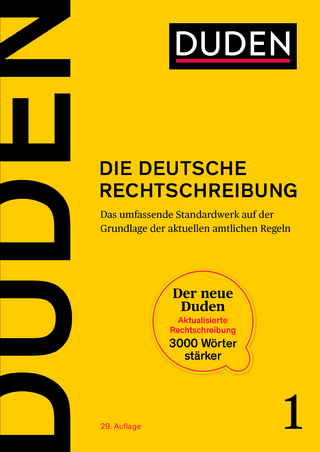
Reversible Grammar in Natural Language Processing
Springer-Verlag New York Inc.
978-1-4613-6173-2 (ISBN)
Most papers collected in this volume are derived from presentations at a workshop held at the University of California at Berkeley in the summer of 1991 organised under the auspices of the Association for Computational Linguistics.
This book will be a valuable reference to researchers in linguistics and computer science with interests in computational linguistics, natural language processing, and machine translation, as well as in practical aspects of computability.
Contributors.- Preface.- 1 A Reversible Constraint-based Iogic Grammar: Application to the Treatment of Secondary Predication and Small Clauses.- 1 Introduction.- 2 A type-based description language.- 3 Dealing with constraints.- 4 Processing Language with types and constraints.- 5 An abstract machine for type construction in a parsing process.- 6 An Abstract Machine for Language Generation.- 7 An Application to Secondary Predications and Small Clauses in Portuguese.- 8 Specific features of our approach.- 9 Conclusion.- 2 Inherently Reversible Grammars.- 1 Introduction.- 2 Definite programs and computation.- 3 Grammars and their computational uses.- 4 Definite programs, uniformity of implementation, and reversibil-ity.- 5 Inherently reversible grammars.- 6 Some counter-examples to finite reversibility and a “modera-tion” condition on linguistic description.- 7 Appendix.- 3 Reversibility and Self- Monitoring in Natural Language Generation.- 1 Introduction.- 2 Reversible grammars.- 3 Modularity in Generation Systems.- 4 Integration of Parsing and Generation.- 5 Generation of Unambiguous Utterances.- 6 Generation of Paraphrases.- 7 Discussion.- 8 Future work.- 4 A Uniform Architecture For Parsing, Generation and Transfer.- 1 Principles for a uniform architecture.- 2 A rewrite machine for typed feature structures.- 3 Parsing, generation, and bidirectional transfer.- 4 The termination problem and efficiency issues.- 5 Conclusion.- 5 Handling Felicity Conditions With A Reversible Architecture.- 1 Introduction.- 2 Felicity Conditions for a Reversible Architecture.- 3 A Data Structure for a Reversible Architecture.- 4 Towards a New Reversible Architecture.- 5 Discussion.- 6 Conclusion.- 6 Common Heuristics for Parsing, Generation, and Whatever.- 1 Introduction.- 2Constraint Network.- 3 Computation.- 4 Parsing.- 5 Generation.- 6 Concluding Remarks.- 7 Compiling Trace & Unification Grammar.- 1 Introduction.- 2 Formalism.- 3 Compiling Trace & Unification Grammar.- 4 Conclusion.- 8 A General Computational Method for Grammar Inversion.- 1 Reversible Grammars.- 2 In and Out Arguments in Literals.- 3 Essential Arguments: An Extension.- 4 Intra-Clausal Inversion.- 5 Moving Literals Between Clauses.- 6 Inter-Clausal Inversion.- 7 Conclusions.- 9 Bi-Directional Preferences.- 1 Introduction.- 2 Basic Definitions.- 3 An Algorithm.- 4 Some Examples of Preferences.- 5 Extensions: Complex Preferences.- 6 Bi-Directional Preferences.- 7 Conclusion.- 10.Handling Syntactic Alternatives in A Reversible Grammar.- 1 Introduction.- 2 The Grammar Formalism and Thematic System.- 3 Discourse Parameters.- 4 How the discourse parameters are encoded in the grammar.- 5 Some Examples.- 6 Discussion.- 7 Conclusions.- 11 Reversible Nlp by Linking the Grammar to The Knowledge Base.- 1 Introduction.- 2 Reversibility through compilation.- 3 The ‘pivot-point’ between generation and comprehension.- 4 Parsing to objects.- 5 Linking linguistic resources to objects.- 6 Summary of the approach.- 7 Parsing Tree Adjoining Grammars.- 8 Exploded Tree Families.- 9 An example of the objects recovered by a parse.- 10 Is it Still a TAG?.- 11 Concluding remarks.- 12 Reversible Grammars and Their Application in Machine Translation.- 1 MT as Knowledge Description.- 2 Grammar Reversibility.- 3 ELU.- 4 Description of the Grammar.- 5 Conclusion.- 13 Reversible Machine Translation: What to Do When the Languages Don’t Match Up.- 1 Introduction.- 2 Translation Divergences and Mismatches.- 3 Viewing the Problem as One of Generation.- 4 The Role of the Knowledge Base.- 5 DefiningWhat it Means to be a Correct Rendition of an Input.- DLSS.- 6 A Closest-Fit Generation Algorithm.- 7 Heuristic Improvements.- 8 Conclusion.- 14 A Generationist Approach to Grammar Reversibility in Natural Language Processing.- 1 The ‘formal linguistics’ approach to the issue.- 2 The argument in a nutshell.- 3 Some supporting evidence: the different problems of processing in the two directions.- 4 The linguistic archipelago.- 5 Fleshing out the argument: overview of a complete system.- 6 Generators derived from parsers: a discussion.- 7 Conclusions.- 15 Semantic Interpretation in a Systemic Functional Grammar.- 1 Introduction.- 2 What About Syntax?.- 3 Overview.- 4 Finding the Features.- 5 Disjunction: Inclusive, Exclusive or Both?.- 6 Conclusions.
| Reihe/Serie | The Springer International Series in Engineering and Computer Science ; 255 |
|---|---|
| Zusatzinfo | XXI, 454 p. |
| Verlagsort | New York, NY |
| Sprache | englisch |
| Maße | 160 x 240 mm |
| Themenwelt | Geisteswissenschaften ► Sprach- / Literaturwissenschaft ► Sprachwissenschaft |
| Mathematik / Informatik ► Informatik ► Programmiersprachen / -werkzeuge | |
| Mathematik / Informatik ► Informatik ► Theorie / Studium | |
| Mathematik / Informatik ► Mathematik ► Analysis | |
| ISBN-10 | 1-4613-6173-7 / 1461361737 |
| ISBN-13 | 978-1-4613-6173-2 / 9781461361732 |
| Zustand | Neuware |
| Informationen gemäß Produktsicherheitsverordnung (GPSR) | |
| Haben Sie eine Frage zum Produkt? |
aus dem Bereich


